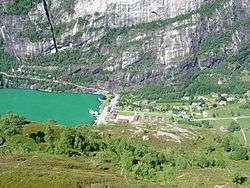Forsand
| Forsand kommune | |||
|---|---|---|---|
| Municipality | |||
|
Lysebotn, located at the head of the Lysefjorden | |||
| |||
 Forsand within Rogaland | |||
| Coordinates: 59°00′49″N 06°25′28″E / 59.01361°N 6.42444°ECoordinates: 59°00′49″N 06°25′28″E / 59.01361°N 6.42444°E | |||
| Country | Norway | ||
| County | Rogaland | ||
| District | Ryfylke | ||
| Administrative centre | Forsand | ||
| Government | |||
| • Mayor (2015) | Bjarte Sveinsvoll Dagestad (H) | ||
| Area | |||
| • Total | 780.05 km2 (301.18 sq mi) | ||
| • Land | 701.30 km2 (270.77 sq mi) | ||
| • Water | 78.75 km2 (30.41 sq mi) | ||
| Area rank | 139 in Norway | ||
| Population (2015) | |||
| • Total | 1,208 | ||
| • Rank | 386 in Norway | ||
| • Density | 1.7/km2 (4/sq mi) | ||
| • Change (10 years) | 9.6% % | ||
| Demonym(s) | Forsandbu[1] | ||
| Time zone | CET (UTC+1) | ||
| • Summer (DST) | CEST (UTC+2) | ||
| ISO 3166 code | NO-1129 | ||
| Official language form | Nynorsk | ||
| Website |
www | ||
|
| |||
Forsand is a municipality in Rogaland county, Norway. It is located in the traditional district of Ryfylke. The administrative centre of the municipality is the village of Forsand. Other villages in the municipality include Lysebotn, Øvre Espedal, Oanes, Kolabygda, and Fløyrli.
Forsand municipality surrounds the famous Lysefjorden and it lies on the east side of the Høgsfjorden. It is one of largest municipalities within the county of Rogaland in terms of area, and one of the smallest in terms of population. Forsand municipality covers 780 square kilometres (300 sq mi) and has a population of 1,208 (as of 2015).[2] In 1999, evidence of a population here dating back to around 7500 BC was located.
General information


The municipality of Fossan was established on 1 January 1871 when the very large municipality of Høgsfjord was divided into two: Fossan (located east of the Høgsfjorden and south of the Frafjorden) and Høle (located west of the Høgsfjorden). Initially, Fossan had 2,081 residents. On 1 January 1965, the municipality was split, with everything located south and east of the Frafjorden being transferred to the neighboring municipality of Gjesdal. This area had no road connection with the rest of Forsand, but it was connected by road to Gjesdal.[3]
Name
The municipality (originally the parish) is named after the old Forsand farm (Old Norse: Forsandr), since the first Forsand Church was built there. The first element is the prefix for which means "outsticking" and the last element is sandr which means "sand" or "sandy beach". Before 1918, the name was written "Fossan".[4]
Coat-of-arms
The coat-of-arms is from modern times. They were granted on 11 March 1988. The arms show a white heron on a green background. They were designed by John Digernes to represent a common bird in the area.[5]
Churches
The Church of Norway has one parish (sokn) within the municipality of Forsand. It is part of the Ryfylke deanery in the Diocese of Stavanger.
| Parish (Sokn) | Church Name | Location of the Church | Year Built |
|---|---|---|---|
| Forsand | Forsand Church | Forsand | 1854 |
| Lyse Chapel | Lysebotn | 1961 |
Geography
Forsand is a large municipality that is very mountainous with a long, narrow fjord running through the middle from east to west. The Lysefjorden is surrounded by very steep 1,000-metre (3,300 ft) tall cliffs such as Kjerag and Preikestolen, with the Lysefjord Bridge crossing the fjord near the western end. The famous Kjeragbolten boulder and Kjeragfossen waterfall are located along the inner part of the fjord. The village of Lysebotn lies at the eastern end of the fjord. The lake Nilsebuvatnet is located high up in the mountains, north of Lysebotn on the border of Strand and Forsand municipalities. It is regulated for hydroelectric power use at the Lysebotn Hydroelectric Power Station.
Government
All municipalities in Norway, including Forsand, are responsible for primary education (through 10th grade), outpatient health services, senior citizen services, unemployment and other social services, zoning, economic development, and municipal roads. The municipality is governed by a municipal council of elected representatives, which in turn elect a mayor.
Municipal council
The municipal council (Kommunestyre) of Forsand is made up of 17 representatives that are elected to every four years. For 2011–2015, the party breakdown is as follows:[6]
| Party Name | Name in Norwegian | Number of representatives | |
|---|---|---|---|
| Labour Party | Arbeiderpartiet | 2 | |
| Conservative Party | Høgre | 3 | |
| Christian Democratic Party | Kristelig Folkeparti | 4 | |
| Centre Party | Senterpartiet | 3 | |
| Local Lists | Lokale lister | 5 | |
| Total number of members: | 17 | ||
References
- ↑ "Navn på steder og personer: Innbyggjarnamn" (in Norwegian). Språkrådet. Retrieved 2015-12-01.
- ↑ "Population and population change, Q3 2015". Statistisk sentralbyrå. 2015. Retrieved 2015-02-25.
- ↑ Jukvam, Dag (1999). "Historisk oversikt over endringer i kommune- og fylkesinndelingen" (PDF) (in Norwegian). Statistisk sentralbyrå.
- ↑ Rygh, Oluf (1915). Norske gaardnavne: Stavanger amt (in Norwegian) (10 ed.). Kristiania, Norge: W. C. Fabritius & sønners bogtrikkeri. pp. 220–225.
- ↑ "Civic heraldry of Norway - Norske Kommunevåpen". Heraldry of the World. Retrieved 2016-02-25.
- ↑ "Table: 04813: Members of the local councils, by party/electoral list at the Municipal Council election (M)" (in Norwegian). Statistics Norway. 2015. Archived from the original on 2016-03-06.
External links
| Wikimedia Commons has media related to Forsand. |
-
 The dictionary definition of Forsand at Wiktionary
The dictionary definition of Forsand at Wiktionary -
 Rogaland travel guide from Wikivoyage
Rogaland travel guide from Wikivoyage - Ryfylke visitors website
- Live web camera from Lysefjord, Forsand




